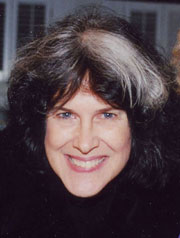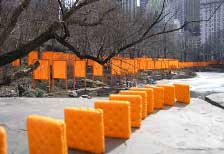 |
→ May 2005 Contents → E-bits
|
E-bits
|
 |
|
It is said that humankind is basically nomadic in nature, and civilization has severely cramped the natural lifestyle we all need and want to have. Once upon a time, we could only travel as far as our feet could take us, and at any given time we would settle only briefly, soon following food sources and weather to favorable locations as they occurred naturally. Planting crops forced us to situate ourselves more permanently so we could tend the growth and harvest the results, and so communal aggregates within these habitats gradually turned permanent, stopping our incessant wanderings. French anthropologist Claude Levi-Strauss, among others, contends we still have the same basic wanderlust of our ancestors, the denial of which has been sporadically satisfied by the use of beasts of burden or horse and buggy for transportation, and later, with industrial steam engines and automobiles, and technological high-speed jet travel and space exploration. But now, in the 21st century, we as individuals have a whole new way to roam the inner and the outer world: The Internet.
The joy of cyberspace lies in images and information from as far away as halfway around the world being available instantaneously at one's fingertips, and one can travel constantly in the mind, if so inclined, without physically leaving home. Bored? Itching to get away? At any chosen moment one need only to sit down with a laptop, log on, and go anywhere. Need a fact? Look it up. Have the answer from multiple sources in seconds. What did Phuket look like before the Tsunami? Just google "beach hotel Thailand" and travel to the Indian Ocean. Want to talk to a long-lost friend? Send an e-mail, or better still, an instant message. Recently, my boyfriend and dancing partner in the '60s and I reminisced on the phone, 1,000 miles away from each other, recalling words and melodies to tunes of that era. When we were stumped for a line we'd forgotten, I simply plopped down in front of my computer, opened up Internet Explorer, and searched the Web for lyrics to tunes and names of artists. Armed with our memories and instant answers, we continued remembering and singing with each other for the next 45 minutes. Not only did we travel through information cyberspace, but we also traveled back in time 40 years to when our memories were formed, when, á la Jimmy Rodgers, "our hearts were full of spring," and our "kisses were sweeter than wine."
When the Christos' THE GATES were in Central Park, my friend called while sitting on a rock not 12 feet away from the billowing saffron-gated path. With her call and seeing so many photographs of the installation, I felt like I was there in person. I could imagine it in a way perhaps not possible even 10 or 15 years ago, aided by so many instantly retrievable images on the computer. I mentally traveled to NYC, walked THE GATES, saw that dazzling color, imagined them flapping in the breeze — all in a flash from my home in Texas, my nomadic lust satisfied for another moment. Cyberspace truly affords a kind of mental travel, and instantly so. Take a look at THE CRACKERS, a very funny parody of the real thing. Can't you just smell them and feel the crisp snow underfoot?
Maybe marathons and races are a way also to soothe the barking dogs of our nomadic nature. Certainly a race well won is as satisfying as a piece of art depicting a great struggle, and great struggles are poetic in nature. Octavio Paz said that the greatest epic poems were works that existed only while they were being told over the course of several days by warriors of a South American tribe. Certainly the cycling Tour de France is an epic, poetic struggle that most of us experience vicariously. For the last few years many of us have been cyber-transporting ourselves to the Pyrénées to follow and celebrate the undisputed hero, cancer survivor, and 6-time tour winner, Lance Armstrong, who lives in my hometown. If I run into him in Austin I'm going to ask him about the nomad theory, and if he thinks the famous race is a modern way of satisfying the same types of urges our nomadic predecessors had. In commemorative honor of the Tour de France in the South of France, this amazing monument in the photo below dominates a motorway service station near Pau, a picturesque city of 100,000 in the Béarn region. Click on the photo for more information about the sculpture.
All of this is to ponder the adage that life is a journey from here to there, and maybe back to here again. Like those before us, we stay briefly in one place mentally in a way that our holistic and nomadic ancestors practiced physically. That is, their entire lives were physical movement from one location or climate to another. Like a pet cat that moves around from one spot to another in the house, we are doing the same thing in our minds. With the multi-miracles of audio and visual technologies, especially the photographic medium and cyberspace, we as The New Nomads have a chance to see what this journey is all about. We are afforded the opportunity to empathize and feel compassion for those of us unlucky enough to be caught in a war zone or natural disaster. Through instant communication of images, reports and stories, we can imagine and therefore know our fellow travelers and see that the human experience is fundamentally the same everywhere. This little video noir from X-Box sums up the brevity of the trip each one of us is taking. Click the photo below to view LIFE.
Many thanks to readers who send E-Bits or write with information about our so-often-unknown sources. We always enjoy hearing from you.
© Beverly Spicer
The links that appear in this column are from the World Wide Web. Credit is given where the creator is known. The Digital Journalist and the author claim no copyright ownership of any video or photographic materials that appear herein. |
|
Back to May 2005 Contents
|
|



